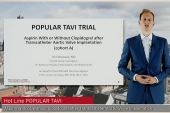Lean Antithrombotic Regimen Recommended After TAVI
In the wake of POPular TAVI, a European consensus statement says less is more while the field awaits additional trial results.

Physicians should aim to use the least amount of antithrombotic therapy as possible in their patients undergoing TAVI, according to a new European consensus statement.
In general, over the long term, patients should be on monotherapy with an oral anticoagulant if they have an indication for it—like atrial fibrillation (AF)—or with low-dose aspirin if they don’t, according to a group led by Jurriën ten Berg, MD, PhD (St. Antonius Hospital, Nieuwegein, the Netherlands). They advise some type of dual therapy in the first 1 to 6 months for patients who have undergone recent coronary stenting before the valve procedure.
Those recommendations, informed heavily by Cohort A (no indication for oral anticoagulation) and Cohort B (an indication for oral anticoagulation) of the POPular TAVI trial, come in the form of a consensus document from the European Society of Cardiology (ESC) Working Group on Thrombosis and the European Association of Percutaneous Cardiovascular Interventions, in collaboration with the ESC Council on Valvular Heart Disease. It was published online last week in the European Heart Journal.
The major message, ten Berg said, “is that these patients are not PCI patients. The guidelines are based on expert opinion and probably based on the data we have from PCI patients.” For that reason, the European guidelines recommend at least some type of double therapy, either dual antiplatelet therapy (DAPT) or clopidogrel plus an oral anticoagulant, after TAVI.
Patients undergoing TAVI, however, tend to be older with more comorbidities placing them at risk for bleeding and, in turn, mortality compared with those undergoing PCI. In addition, ten Berg noted, an acquired von Willebrand factor defect is common in patients undergoing TAVI.
“So the major message is to avoid double antithrombotic therapy in these patients,” he said. “It’s safe to treat them with just aspirin, or maybe clopidogrel, and just an oral anticoagulant, whether this is a vitamin K antagonist or a [direct oral anticoagulant]. But do not add a double antiplatelet agent to this regimen.”
Ten Berg told TCTMD the group was motivated to publish the statement even while awaiting the results of further trials—like ATLANTIS and ENVISAGE-TAVI AF—to provide some guidance to clinicians while the update to the European valve guidelines, anticipated for the end of the year, is still ongoing.
There remains uncertainty about the optimal approach to antithrombotic therapy in patients undergoing TAVI. The 2017 valvular heart disease guidelines from the ESC and the European Association for Cardio-Thoracic Surgery recommend either DAPT with low-dose aspirin and clopidogrel for 3 to 6 months followed by ongoing single antiplatelet therapy or oral anticoagulation for those with an indication for it. The more-recent 2020 American guidelines recommend lifelong low-dose aspirin after TAVI, leaving open the option for aspirin plus clopidogrel or a vitamin K antagonist (VKA) for 3 to 6 months in patients with a low bleeding risk.
For this new consensus statement, ten Berg, principal investigator of the POPular TAVI trial, and colleagues reviewed recent studies to provide an update on the evidence and recommendations for management of antithrombotic therapy during and after TAVI.
The consensus document includes a graphical algorithm to guide clinicians through the choice of antithrombotic therapy before, during, and after the procedure, divided according to whether patients have an indication for oral anticoagulation.
In patients already taking oral anticoagulation, the decision about continuing or interrupting treatment for TAVI should be individualized, ten Berg et al say; he mentioned that this is an area of active research that has not yet been resolved. In those without an indication for anticoagulation, low-dose aspirin monotherapy is the treatment of choice leading up to the procedure, with clopidogrel an alternative if aspirin is not an option.
For all patients, unfractionated heparin with a target activated clotting time of 250 to 300 s is preferred during the procedure, although bivalirudin can be used if there are contraindications. It’s deemed reasonable to use embolic protection in patients with a high stroke risk or protamine sulfate to reverse anticoagulation before closure of the access site.
After the procedure, decisions about antithrombotic management are based on whether patients have an existing indication for oral anticoagulation and whether they underwent PCI in the 3 months before the procedure.
For patients who require chronic anticoagulation and who underwent a recent PCI, post-TAVI treatment should include oral anticoagulation plus clopidogrel or aspirin for 1 to 6 months, followed by lifelong anticoagulation monotherapy. In the absence of a recent PCI, anticoagulation monotherapy is recommended starting after the procedure.
Due to the lack of adequate data, there’s no preference stated for the type of oral anticoagulant used, ten Berg said. POPular TAVI Cohort B showed that using a direct oral anticoagulant alone reduced bleeding, with a noninferior difference in the composite of CV death, stroke, or MI, compared with a direct oral anticoagulation (DOAC) plus clopidogrel. A Danish registry study showed no differences in bleeding or adverse clinical outcomes between VKA and DOAC therapy in patients undergoing TAVI, whereas a German registry showed that DOACs fared worse. Ongoing trials will be needed to sort out the issue, ten Berg said.
Recommendations in patients without an indication for oral anticoagulation were informed by observational studies, the small ARTE trial, GALILEO, and POPular TAVI Cohort A. In this group of TAVI patients, DAPT with low-dose aspirin and clopidogrel should be used for 1 to 6 months, followed by single antiplatelet therapy, in patients with a recent stenting. In the absence of a recent PCI, single antiplatelet therapy is recommended starting after the procedure.
The duration of dual therapy in all cases should be based on assessments of bleeding risk, the authors say. “In the absence of direct evidence, the duration of dual therapy should follow post-PCI recommendations, but should again be as short as possible (1 to 6 months) based on the bleeding risk,” they write. “When TAVI is performed early post-PCI, it is unknown whether antithrombotic therapy should be continued peri-TAVI, but expert opinion advises continuing when PCI has been performed within 3 months because the risk for stent thrombosis is highest within this time frame.”
Over the long term, ten Berg et al stress, there should be periodic reassessments of bleeding risk to guide antithrombotic therapy.
Ten Berg said he’s already seen changes in practice based on the results of the POPular TAVI trial, with hospitals using leaner antithrombotic regimens in the TAVI population. In the Netherlands, for example, he estimated that more than 90% of TAVI patients are treated with aspirin or anticoagulation monotherapy after the procedure.
Consensus statements like this one can help spur further changes in clinical practice while the field waits for guideline updates, he said. “This is more [about] practical management in a consensus statement. It’s how we treat our patients based on observations in high-volume centers. So I do think it’s quite influential and it will lead to the same regimen in many other countries.”
Todd Neale is the Associate News Editor for TCTMD and a Senior Medical Journalist. He got his start in journalism at …
Read Full BioSources
Ten Berg J, Sibbing D, Rocca B, et al. Management of antithrombotic therapy in patients undergoing transcatheter aortic valve implantation: a consensus document of the ESC Working Group on Thrombosis and the European Association of Percutaneous Cardiovascular Interventions (EAPCI), in collaboration with the ESC Council on Valvular Heart Disease. Eur Heart J. 2021;Epub ahead of print.
Disclosures
- Ten Berg reports lecture or consultancy fees from AstraZeneca, Eli Lilly, Daiichi Sankyo, The Medicines Company, AccuMetrics, Boehringer Ingelheim, Bristol-Myers Squibb, Pfizer, Bayer, Ferrer, and Idorsia; as institutional research grants from ZonMw and AstraZeneca.





Comments